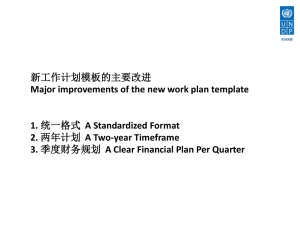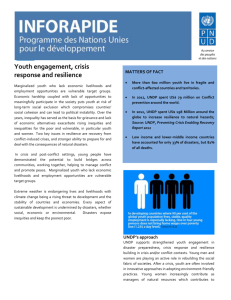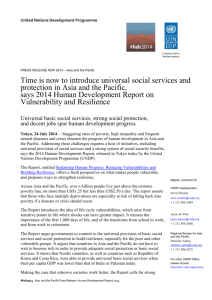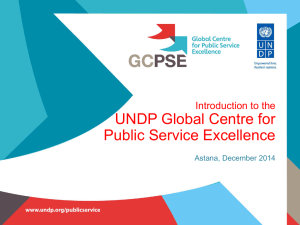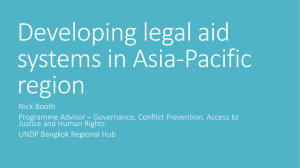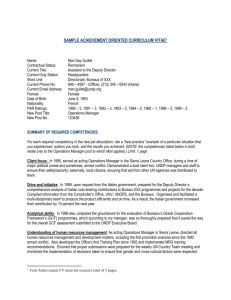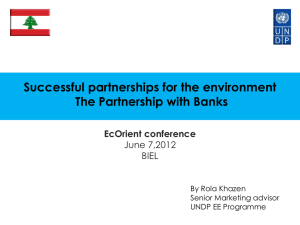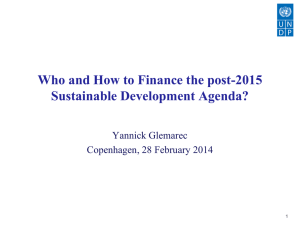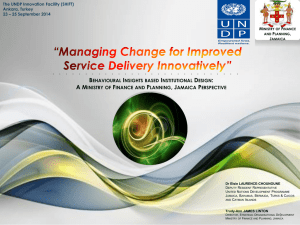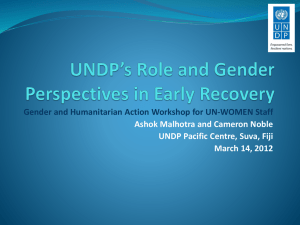Why youth for development?
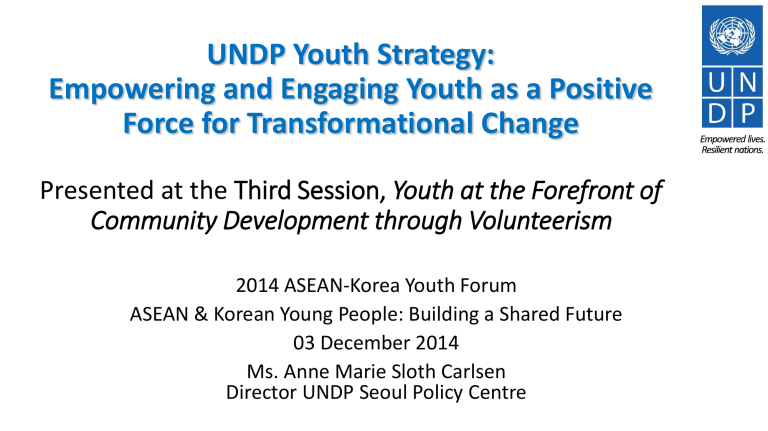
UNDP Youth Strategy:
Empowering and Engaging Youth as a Positive
Force for Transformational Change
Presented at the Third Session, Youth at the Forefront of
Community Development through Volunteerism
2014 ASEAN-Korea Youth Forum
ASEAN & Korean Young People: Building a Shared Future
03 December 2014
Ms. Anne Marie Sloth Carlsen
Director UNDP Seoul Policy Centre
The UNDP Seoul Policy Centre for Global Development Partnerships
• One of six UNDP Global Policy Centres
• Established 2011 to represent UNDP in Korea and to work with Korea in international issues and share experience with other countries
• Hosted by Korea University
• Website: www.undp.org/uspc
• Facebook: www.facebook.com/undpspc
Why youth for development?
• More than 1.2 billion youth, aged 15-24: largest generation of young people the world has ever known
• More than 60 percent of the population in many UNDP programme countries are youth
• Their opportunities for communicating, acting and influencing are unprecedented.
• Also, the challenges they face are unprecedented, from climate change to unemployment to multiple forms of inequalities and exclusion, in particular for youth belonging to vulnerable or marginalized groups.
• Institutional public space is scarce for young men and women; if war was a tragedy for all, peace is difficult for them and jobs are hard to get and tough to keep.
• Youth participation is crucial to achieving sustainable human development
“Youth are often the first to stand against injustice… Young people are a force for transformation .”
-
UN Secretary-General Ban Ki-moon
Photo: Malala Yousafzai, born in 1997, is a Pakistani activist for female education and the youngest winner of Nobel Peace Prize in history. She is known for human rights advocacy for education and for women in northwest Pakistan, where the local Taliban had at times banned girls from attending school. She was shot for her activism by a gunman, but survived the assassination attempt.
Yousafzai's advocacy has since grown into an international movement.
• Young people as agents of
positive change in society.
• They can call for institutions to national or global concerns.
• They can provide the energy, creative ideas and determination to drive reform.
• They can increasingly develop their own solutions to global challenges.
Youth and the Post-2015 Development Agenda
• The youth have made their voices heard about the future they want, during the post-2015 UN consultations, aimed at identifying the new agenda for development.
• Unprecedented open process through which inputs have been sought on the design of the post-2015 agenda
• 63% of the 5.2 million MY World votes come from the 16-30 age category
• Another 14% from are under the age of 14
• Young people have demanded education, jobs, honest and responsive governments, and greater and meaningful participation in decision-making.
• Their voices matter because key development challenges today (such as economic injustice, climate change, environment degradation) are
intergenerational issues for which the young generation today will become the future custodians
• Young people need to become part of the implementation mechanisms and accountability fabric around the new development agenda.
UNDP Youth Strategy (2014-2017)
• UNDP’s first-ever corporate Youth Strategy, “Empowered Youth, Sustainable
Future”, is about resilience, sustainable and human development, and effective and democratic governance.
• It calls on the young generations to become even more committed agents of change in development processes.
• Together with the United Nations Secretary-General’s Envoy on Youth, UNDP is also increasing its engagement with young women and men, their organizations, and other stakeholders that matter.
• Uses a flexible definition of ‘youth’
While the focus is on young women and men aged 15−24, the range may extend to 30 and even up to 35 depending on national context, and will remain flexible to ensure that programming related to the implementation of the strategy is responsive to the diverse needs of youth in different country contexts.
• In order to have the youth at the forefront of community developing through volunteerism, the topic of this session, we need to empower and engage these young people to expand their capabilities and opportunities in ways that are sustainable from the economic, social and environmental standpoints
ways and means to achieve UNDP’s Vision for “Sustainable Human
Development” as in the UNDP Strategic Plan (2014-2017)
“UNDP supports policy and programming aiming to ensure that youth are informed, engaged and empowered to contribute to sustainable human development and resilience of their communities. The combination of youth and innovation has the potential to create solutions to development challenges and to transform societies.”
Helen Clark, Administrator, UNDP
Helen Clark visits
Vientiane Youth
Center in Lao PDR
UNDP Youth Strategy: Main Expected Outcomes
1. Youth are economically empowered
• Decent work and livelihood creation are chief determinants in the socio-economic empowerment of youth; they also contribute to sustainable human development overall.
• Success means increasing the quantity of jobs for young people. It also requires enhancing the quality of jobs by improving their productivity, facilitating movements of young people to more productive sectors, and increasing access to social protection.
• Access to finance and markets is one area for action—with skill building for young entrepreneurs, in particular young women, support for social enterprises, and publicprivate employment opportunities.
• Non-formal education will build skills for employability, internships and apprenticeships, and better access to job market data and job centres.
• Fostering a policy environment conducive to job creation for young people.
UNDP Youth Strategy: Main Expected Outcomes
2. Youth are engaged in public life and participate in political processes and institutions
• When young men and women understand their rights, they can become empowered to engage in civil society, public service and political processes, at all levels.
• They need to know the channels through which they may exercise their civil and political rights and contribute to decision-making processes that impact their lives.
Channels for engagement include formal political processes such as youth advisory boards at local level, youth parliaments or shadow councils at national level, and engagement with
United Nations processes at the global level, for example.
Other entry points include volunteerism, access to civil service positions and decision-making processes in the public administration, initiatives for transparency and accountability, promotion of human rights, legal reform, support for youth organizations, policy review and use of media, including social media, to increase access to information and collect and report on relevant data.
UNDP Youth Strategy: Main Expected Outcomes
3. Youth are agents for community resilience
Youth can be positive agents of change in their communities in time of conflict and disaster.
Early action to stabilize their livelihoods builds resilience and supports social cohesion; it also provides alternatives as conflict prevention for at-risk youth.
Strategic entry points focus on mobilizing and empowering youth as positive agents of change in their communities, including emergency employment and entrepreneurship and recovery of critical livelihoods assets such as skills development and access to finance.
Youth also can be mobilized in disaster preparedness, education and postdisaster efforts—e.g. managing natural resources, mobilizing communities via new technologies, acquiring peace-building skills, or supporting efforts to reduce gender-based violence.
Contribution of Youth to Development through
Volunteerism
Volunteerism:
• Provides opportunities for young people to become active leaders and citizens in their diversity
• Fosters their inclusion in global peace and sustainable human development processes.
Photo: UNV Youth Volunteer Giulia Giannuzzi took part in the “Orange the Journey Campaign to End
Violence against Women and Girls” in 2013.
Youth bring direct benefits to their communities by
• Identifying problems
• Finding solutions
• Bringing valuable insights and inspiration from the youth perspective often providing new technological skills
Example of UNDP Engagement with Youth
Volunteerism
UNDP Project, “Making Timor-Leste Beautiful”
• Approximately 60 % of the country’s 1.2 million
people are under the age of 25.
• The UNDP youth initiative supported by Korea raises awareness about environmental issues and creates job opportunities for young people at the same time
• Since December 2013, the launch of the project,
more than 3 million plastic bottles were collected for recycling.
Photo: Timorese students clean up the streets of Dill, the capital city.
